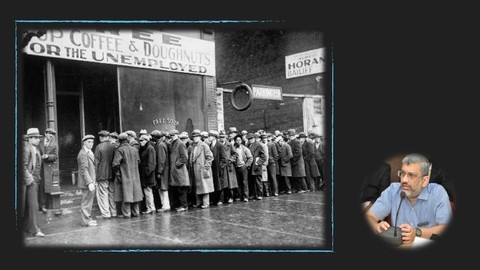Macroeconomics is a fascinating field that delves into the workings of economies on a large scale, exploring concepts like economic growth, inflation, unemployment, and the impact of government policies.
By understanding macroeconomics, you can gain insights into how the world economy functions, make informed financial decisions, and even contribute to shaping economic policies.
Whether you’re a student, a business professional, or simply a curious individual, a solid grasp of macroeconomics can be invaluable.
Finding the right macroeconomics course on Udemy, however, can feel like navigating a labyrinth of options.
You’re searching for a course that not only explains the complex theories but also makes them relatable and applicable to real-world scenarios.
You want engaging instructors, practical examples, and a learning experience that fits your pace and style.
We’ve meticulously reviewed numerous Udemy courses on macroeconomics and are confident in recommending Macroeconomics: A Comprehensive Economics Course as the best overall choice.
This comprehensive course provides a solid foundation in macroeconomic principles, covering everything from fundamental concepts to advanced topics, all presented in a clear and engaging manner.
The instructor’s expertise and passion for the subject shine through, making learning both enjoyable and effective.
This is just one of the many excellent macroeconomics courses available on Udemy.
If you’re looking for something more specific to your needs or interests, we encourage you to keep reading.
We’ve compiled a list of recommendations tailored to different learning styles and goals, ensuring you find the perfect course to embark on your macroeconomic journey.
Macroeconomics: A Comprehensive Economics Course
This macroeconomics course takes you on a deep dive into the workings of economies on a large scale.
You begin with the basic building blocks, learning how economists measure economic activity using key concepts like GDP, GNP, and GNI.
You’ll also unravel the intricacies of national income statistics and their role in understanding an economy’s health.
The course then guides you through the forces that drive aggregate demand and aggregate supply.
You’ll develop a firm grasp of the components of aggregate demand, including consumer spending, business investment, government expenditure, and net exports.
You’ll also discover how fiscal and monetary policies, the tools governments use to influence the economy, impact aggregate demand.
Next, you’ll explore how aggregate demand and aggregate supply interact to determine the overall level of economic activity, a state known as macroeconomic equilibrium.
You’ll learn to use powerful visual tools like the “Rule of 10” and “Rule of 9” diagrams to understand these interactions.
The course also delves into two major schools of economic thought – Neoclassical and Keynesian perspectives – providing you with a well-rounded understanding of how economists interpret economic phenomena.
You will then shift focus to critical macroeconomic objectives, such as achieving low unemployment and maintaining stable prices.
You’ll learn to identify the causes of unemployment, including frictional, structural, and cyclical unemployment, and analyze the costs it imposes on an economy.
The course explores various government policies designed to tackle unemployment.
You’ll then delve into the different forms of inflation, understand its associated costs, and explore how governments utilize monetary and fiscal policies to keep it in check.
You’ll also examine the phenomenon of deflation and master the techniques for accurately measuring inflation.
Understanding Macroeconomics for University and Business
This course equips you with a powerful understanding of how economies function on a large scale.
You begin by learning how economists measure a nation’s economic output.
You then tackle unemployment and inflation, discovering how these forces impact individuals and businesses.
The course guides you through the framework of macroeconomic theory, where you discover how consumption, investment, and government spending interact to shape economic equilibrium.
You’ll learn how an initial change in spending can cascade through an economy with the multiplier effect.
You then delve into the role of money, its creation, and its effects on the financial system.
Finally, you develop a deep understanding of how interest rates influence economic activity and how policymakers leverage fiscal and monetary policy to manage the economy.
This includes navigating complex macroeconomic problems such as recessions, stagflation, and hyperinflation.
You will analyze their causes and explore how governments can address them.
Economics: Macroeconomic Fundamentals for Managers
This course equips you with the knowledge to understand how macroeconomic forces impact your business.
You will begin with the foundation of GDP, learning how it’s calculated and its significance as a measure of economic health.
You will then explore how governments use fiscal and monetary policy tools to manage their economies.
Using Google Public Data, you will compare GDP trends across different countries, gaining practical experience with real-world data analysis.
The course takes you further into the complexities of globalization, examining how specialization and trade drive wealth creation.
You will learn about labor arbitrage and its implications for offshoring, understanding how businesses navigate these global dynamics.
You will also explore the impact of environmental limitations, risk assessment, and innovation on economic development.
The course doesn’t just stop at theory; it provides you with practical tools and insights.
You will learn from the expertise of economists like Mish Shedlock and Charles Hugh Smith through EazlViews, gaining unique perspectives on financial crises and economic cooperation.
Additionally, you will develop data research skills with SideBySides, mastering techniques to analyze economic data from user-friendly public resources.
The Macroeconomics Course
This macroeconomics course thoroughly covers everything from foundational principles to the complexities of international trade.
You will start with the essentials, learning how to calculate GDP using both the expenditure and income approaches.
You will also discover the difference between nominal and real GDP and how changes in aggregate demand and supply can impact the overall economic balance.
The course then delves into the intricacies of economic cycles, exploring the various phases a cycle goes through and how factors like resource use, the housing market, and external trade come into play.
You will also examine the causes and types of unemployment and gain a comprehensive understanding of inflation, including its causes, how to measure it, and the limitations of these measurements.
You will then explore monetary and fiscal policy, the important tools governments use to guide their economies.
You will develop a firm understanding of money creation, how central banks operate, and the effects of their policies.
This includes diving into the monetary transmission mechanism and exploring how different monetary policy tools work.
On the fiscal side, you’ll learn how governments use tools like taxation and government spending to influence the economy.
The course will equip you to analyze the effects of these fiscal policies and understand their potential limitations.
Finally, you will unravel the intricacies of international trade, weighing its costs and benefits while examining the concepts of comparative and absolute advantage.
You will also explore the impacts of trade restrictions, learn about trading blocs, and understand how the balance of payments works.
Strategic Macroeconomics for Business & Investing
This strategic macroeconomics course equips you with the tools to analyze economic forces shaping business and investment decisions.
You begin by exploring fundamental macroeconomic concepts such as inflation, interest rates, and business cycles.
You quickly delve into the Aggregate Supply-Aggregate Demand Model, a key framework for understanding economic fluctuations.
This model provides valuable insights for making informed investment decisions, especially when navigating the complexities of fiscal and monetary policy.
The course then introduces you to the influential ideas of John Maynard Keynes, exploring his perspective on economic management through government intervention.
You learn about the Keynesian Expenditure Multiplier, a key concept for understanding the impact of fiscal policy on economic activity.
This knowledge helps you grasp the interplay between government actions and market responses.
The course goes beyond theory, offering practical guidance on managing inflation risks and making strategic investments amidst an ever-changing economic landscape.
You then examine economic growth models, from the Classical theories of Adam Smith and Thomas Malthus to the Neoclassical model incorporating technological change.
This exploration reveals the factors influencing economic progress in both developed and developing countries.
The course doesn’t shy away from international trade, delving into concepts like absolute and comparative advantage.
You’ll gain a nuanced understanding of protectionism, exchange rates, and the intricacies of the global economy, all crucial for navigating international business.
Finally, you’ll develop a keen understanding of public finance and the implications of government debt and budget deficits.
The course culminates by equipping you with practical strategies for business cycle management.
This includes utilizing a GDP Forecasting Model and mastering skills in strategic marketing, operations, supply chain management, corporate finance, and credit management.
Armed with these tools, you can confidently navigate the complexities of the global economy, making informed decisions that drive business growth and investment success.
(Oxford) Diploma : Macroeconomics/Behavioural Economics
This Oxford Diploma course takes you deep into the world of macroeconomics and behavioral economics, equipping you with a solid understanding of how economies work on a grand scale.
You’ll learn about crucial concepts like economic growth, inflation, unemployment, and the impact government policies have on these factors.
The syllabus brings these concepts to life with real-world examples, like the COVID-19 pandemic’s effect and the implications of Brexit on economies.
Prepare to analyze the current global economy and understand how economic indicators impact countries such as the USA, the UK, and Nigeria.
You’ll explore how major economic events, like the war in Ukraine, influence global economies.
You’ll also delve into behavioral economics, which examines how psychological factors influence the economic decisions people make, shaping outcomes like the rise of the gig economy.
The course uses a blend of lectures, quizzes, and activities that challenge your grasp of theoretical knowledge and encourage practical application.
You will learn to analyze economic data, understand economic indicators, and even make your own predictions about future economic trends.
This course doesn’t just tell you about economics; it helps you experience it.
You’ll even use mind mapping, a powerful technique for organizing and remembering information.
Macroeconomics: A Modern Money Theory Perspective
This course guides you through the complexities of modern macroeconomics, focusing on Modern Monetary Theory (MMT) and its unique perspective.
You start with the fundamentals, exploring the history of macroeconomic thought from classical to Keynesian economics and the rise of the neoliberal paradigm.
This foundation prepares you to dive into the core principles of MMT.
You develop a firm grasp of modern money, its hierarchy within monetary institutions, and the importance of interpreting balance sheets and T-accounts.
The course equips you with the skills to analyze liquidity issues and understand the flow of money within a four-sector economy.
You then transition into the realm of fiscal policy, contrasting mainstream views with the MMT perspective.
You learn to analyze the impact of fiscal deficits, public debt, and the mechanics of fiscal policy operations.
This course challenges the traditional understanding of banking and credit.
You learn about the shortcomings of the defunct money multiplier model and explore the concept of endogenous money creation.
You delve into bank operations, the intricacies of the interbank money market, and the crucial role central banks play in cash creation.
You then explore monetary policy and central bank operations, learning how these function in theory and practice, particularly from the MMT viewpoint.
The course covers unconventional monetary policies such as quantitative easing (QE) and negative interest rates (NIRP), their theoretical basis, and how they are implemented.
The course equips you with the tools to dissect complex economic events.
You gain a deeper understanding of inflation, profits, and unemployment through the lens of MMT.
You learn about the Kalecki-Levy profits equation and its implications for profits and price levels.
This exploration extends to analyzing the potential effects of policy options like the Universal Job Guarantee (UJG) and Universal Basic Income.
You finish the course by examining macroeconomic country studies through the framework of sectoral financial balances.
You learn to analyze both closed and open economies, applying these skills to real-world case studies of countries like Iran, Germany, France, Ireland, Italy, and Spain.
Principles of Macroeconomics
This course equips you with the tools to analyze an economy’s performance.
You will learn to calculate Gross Domestic Product (GDP) to understand the total value of goods and services a country produces.
You will also discover how the Consumer Price Index (CPI) tracks price changes over time, revealing the rate of inflation.
The course then delves into the labor market, showing you how economists measure its health using indicators like employment and wages.
You will then explore the dynamics of consumption and savings, understanding their impact on economic growth through models like the Solow Growth Model.
Building on this, the course unravels the role of investment in economic activity and how it interacts with savings.
You will explore monetary policy, learning how central banks manipulate interest rates and the money supply to influence the economy.
Finally, the course unpacks the powerful forces of aggregate supply and demand, demonstrating how they determine an economy’s overall price levels and output.
You will then learn how governments use fiscal policy tools, such as government spending and taxation, to stabilize their economies.








